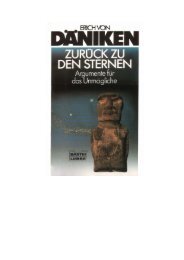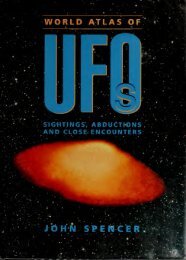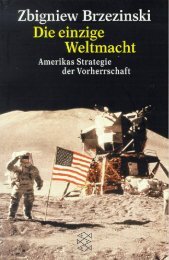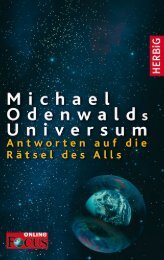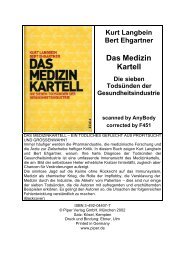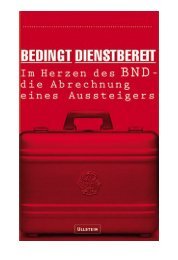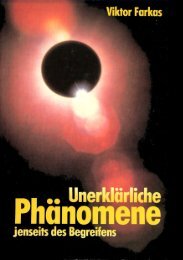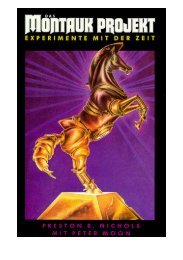Erfolgreiche ePaper selbst erstellen
Machen Sie aus Ihren PDF Publikationen ein blätterbares Flipbook mit unserer einzigartigen Google optimierten e-Paper Software.
Quellen der Karten<br />
Die Quellenangaben wurden so gestaltet,<br />
dass Internet-Recherchen möglichst einfach sind<br />
Mehrfach verwendete Abkürzungen:<br />
AFP Agence France-Presse<br />
AMAP Arctic Monitoring and Assessment Programme<br />
ADB Asian Development Bank<br />
BAN Basel Action Network<br />
CEIP Carnegie Endowment for International Peace<br />
CEPII Centre d’études prospectives et d’informations<br />
internationales<br />
CNRS Centre national de la recherche scientifique<br />
DoD U.S. Department of Defense<br />
EEA European Environment Agency<br />
EIA U.S. Energy Information Administration<br />
FAO Food and Agricultural Organization<br />
FAS Federation of American Scientists<br />
HDR Human Development Report (UNDP)<br />
HRW Human Rights Watch<br />
IEA International Energy Agency<br />
Ifremer Institut français de recherche pour<br />
l’exploitation de la mer<br />
IISS International Institute for Strategic Studies<br />
ILO International Labour Organisation<br />
IMF International Monetary Fund<br />
Inalco Institut national des langues et civilisations<br />
orientales<br />
Isemar Institut supérieur d’économie maritime<br />
ISAAA<br />
Jetro<br />
Migrinter<br />
Nato<br />
NTI<br />
OCHA<br />
OECD<br />
OSZE<br />
UN<br />
Unctad<br />
UNDCP<br />
UNDESA<br />
UNDP<br />
Unep<br />
UNHCR<br />
Unicef<br />
U.S.<br />
USDA<br />
USGS<br />
WFP<br />
WMO<br />
WTO<br />
International Service for the Acquisition<br />
of Agri-Biotech Applications<br />
Japan External Trade Organization<br />
Migrations Internationales<br />
North Atlantic Treaty Organisation<br />
Nuclear Threat Initiative<br />
UN Office for the Coordination<br />
of Humanitarian Affairs<br />
Organization for Economic Cooperation and<br />
Development<br />
Organisation für Sicherheit und Zusammenarbeit<br />
in Europa<br />
United Nations<br />
UN Conference on Trade and Development<br />
UN International Drug Control Programme<br />
UN Department of Economic and Social Affairs<br />
UN Development Programme<br />
UN Environment Programme<br />
UN High Commissioner for Refugees<br />
UN Children’s Fund<br />
United States of America<br />
U.S. Department of Agriculture<br />
U.S. Geological Survey<br />
UN World Food Programme<br />
World Meteorological Organization<br />
World Trade Organisation<br />
Seite 14/15<br />
1: AMAP, 1998, 2002, 2004. • World Con ser va -<br />
2<br />
tion Monitoring Centre (WCMC). • EIA.<br />
• National Oceanic and Atmospheric Admi -<br />
1 3 nistration (NOAA). • International Perma frost<br />
Association (IPA). • »Impacts of a warming<br />
Arctic: Arctic Climate Impact Assessment (ACIA) overview<br />
report«, Cambridge University Press, 2004. • Vital Arctic<br />
Graphics, People and Global Heritage on Our Last Wild<br />
Shores, Unep/Grid-Arendal, 2005. 2: National Aeronautics<br />
and Space Administration (Nasa), 2004; nach einer Karte von<br />
Frédéric Durand. 3: »Impacts of a warming Arctic« (s. o.<br />
»ACIA«). Hadley Centre, 2005. WMO, 2005. Met Office, 2005.<br />
Seite 16/17<br />
2<br />
1, 2: Jean Robert Petit, Jean Jouzel u. a.,<br />
»Climate and atmospheric history of the past<br />
1<br />
3<br />
420.000 years from the Vostok ice core in<br />
Antarctica«, in: Nature 399 (Mai/Juni 1999).<br />
• David Stainforth, ClimatePrediction.net,<br />
2005. • Intergovernmental panel on climate change (IPCC). •<br />
Unep/Grid-Arendal, 1998. 3: School of Environmental<br />
Sciences, Climatic Research Unit, University of East Anglia,<br />
1999. • Hadley Centre, 2005. • WMO, 2005. • Met Office, 2005.<br />
Seite 18/19<br />
1<br />
2<br />
1: Le Monde diplomatique.<br />
2: World Resources Institute (WRI).<br />
Seite 20/21<br />
1: Ifremer. • FAO. • »Ecosystems and Human<br />
2<br />
Well-Being«, Synthesis, Millennium<br />
Ecosystem Assessment, 2005. • Nach einer<br />
1<br />
3 Karte von François Carré, Université de Paris-<br />
IV. Darstellung: Gall-Bertin-Projektion.<br />
2: La Situation mondiale des pêches et de l’aquaculture 2004<br />
und Annuaire statistique des pêches 2002, FAO • Global<br />
Database on Marine Fisheries and Ecosystems, Sea Around US<br />
Project, Fisheries Centre, University of British Columbia<br />
(www.seaaroundus.org). • UNEP/GRID-Europe. 3: Ecosystems<br />
and Human Well-Being, Synthesis, Millennium Ecosystem<br />
Assessment, 2005 • Global Database on Marine Fisheries and<br />
Ecosystems, Sea Around US Project, Fisheries Centre,<br />
University British Columbia (www.seaaroundus.org).<br />
Seite 22/23<br />
1<br />
2<br />
3<br />
4<br />
1: Worldwatch, 2005. 2: IEA, World Energy<br />
Statistics, 2004. • BP, Statistical Review of<br />
World Energy, 2004. • Französisches Indus -<br />
trie ministerium. • AG Energiebilanzen, 2003.<br />
3: AMAP, 1998 4: International Atomic Energy<br />
Agency (IAEA). • CEIP, 2005. • International Nuclear Safety<br />
Center (INSC), 2002. Christian Bataille, Henri Revol, »Rapport<br />
sur les incidences environnementales et sanitaires des essais<br />
nucléaires effectués par la France entre 1960 et 1996 et<br />
éléments de comparaison avec les essais des autres<br />
puissances nucléaires«, Französische National ver samm lung<br />
(Bericht 3571) und Senat (Bericht 207), 2002.<br />
Seite 24/25<br />
3 4<br />
1: Internationales Institut für angewandte Sys -<br />
temanalyse (IIASA), 2005. 2,3: »La Pro duc tion<br />
1<br />
d’électricité d’origine renouvelable dans le<br />
2<br />
monde, sixième inventaire«, Observatoire des<br />
énergies renouvelables (Observ’ER).<br />
• Electricité de France (EdF), 2004. 4: Global Chance, 2005<br />
Seite 26/27<br />
1 3<br />
2: »Elecnuc. Les centrales nucléaires dans le<br />
monde«, Commissariat à l’énergie atomique<br />
(CEA), 2004. • Bruno Barillot, »Le complexe<br />
2<br />
4<br />
nucléaire, des liens entre l’atome civil et<br />
l’atome militaire«, Editions CDRPC, Lyon,<br />
2005. 3: NTI. • »Bulletin of the Atomic Scien tists«, FAS •<br />
Natural Re sour ces Defense Council (NRDC). • Educational<br />
Foundation for Nuclear Science (EFNS). • CEIP.<br />
4: »Bulletin of the Atomic Scientists«, FAS.<br />
Seite 28/29<br />
1: Environment and Security Initiative,<br />
2<br />
»Central Asia-Ferghana« (2005), »The case of<br />
Central Asia and South Eastern Europe«<br />
1<br />
3 (2003). • UNDP. • OSZE. • Nato. • Unep-Europe,<br />
Unep/Grid-Arendal. 2: Daniel C. Esty, Marc<br />
Levy u.a., »Environ men tal Sustainability Index:<br />
Benchmarking National En vi ron mental Stewardship«, Yale<br />
Center for Environmental Law and Policy, Yale Univer sity,<br />
2005. 3: Unep. • Bellona Foundation. • Ifremer.<br />
• La Documentation française. • »Planet Ecology«.<br />
• The Corporation.<br />
Seite 30/31<br />
2 3<br />
1: BAN. • Silicon Valley Toxics Coalition.<br />
• To xics Link India, Scope (Pakistan).<br />
• Green peace. • ILO. • International Maritime<br />
1<br />
4 Orga nization (IMO). 2: »Environmental<br />
Outlook for the Chemicals Industry«, OECD,<br />
2001. 3: OECD, 1999. 4: BAN, Mai 2005.<br />
• Sekretariate der einzelnen Konventionen.<br />
Seite 32/33<br />
1<br />
2<br />
3 4<br />
5<br />
1: Unctad, Online-Daten. • Images<br />
écono miques du monde, Sedes, 2006.<br />
• Inter na tional Iron and Steel Institute (IISI).<br />
2, 3, 4, 5: Unctad, Online-Daten, 2005.<br />
Seite 34/35<br />
1: FAO Yearbook, 2004. 2: Unicef. • Demo gra -<br />
2<br />
phic and Health Surveys (DHS). • UNDP,<br />
1<br />
3<br />
Län der berichte. • African Nutrition Database<br />
Ini tiative (Andi). 3: FAO Statistical Database.<br />
• »The State of Food Unsecurity in the World«,<br />
FAO, 2005. • Millennium Eco sys tem Assess ment.<br />
Seite 36/37<br />
1: FAO Biotechnologies in Developing<br />
2 Coun tries Database (FAO-BioDeC), 2005.<br />
1<br />
3<br />
2: ISAAA, 2004. • FAO, 2005. • International<br />
Federation of Organic Agriculture Movements<br />
(Ifoam), 2005. • Institute for Health and<br />
Consumer Protection (IHCP) of the European Com mis sion’s<br />
Joint Research Centre (JRC). 3: ISAAA, 2004. • Mon santo,<br />
2005. • Clive James. • USDA.<br />
Seite 38/39<br />
1: UNDESA (Population Division), Population<br />
2<br />
Ageing 1999. • UN Population Information<br />
Network (POPIN, www.un.org/popin/).<br />
1 3 4<br />
2: Daniel Noin, Atlas de la population mon -<br />
diale, Reclus – La Documentation française,<br />
1991. Die Karte wurde nach neueren Zahlen des UNDESA (Po-<br />
pu lation Division) und des Entwic klungs programms der Ve -<br />
reinten Nationen und der Weltbank aktualisiert. 3: UNDESA,<br />
World Population 1998, The World at Six Billion (Oktober<br />
1999) und World Population Prospects: The 2000 Revision<br />
(Februar 2001). 4: UNDESA, The World at Six Billion (Oktober<br />
1999) und World Population Prospects: The 2004 Revision.<br />
234



